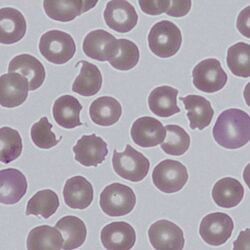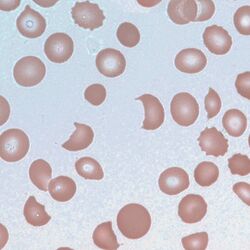Keratocytes: Difference between revisions
From haematologyetc.co.uk
No edit summary |
No edit summary |
||
| Line 1: | Line 1: | ||
horned cells, bite cells, helmet cells) | horned cells, bite cells, helmet cells) | ||
Derivation: Latin Kerat (horn) | Derivation: Latin Kerat (horn) | ||
Appearance Keratocytes usually have a single pair of spicules hence the name horned cells. The spicules generally frame a concave area of cell membrane, this gives rise to the alternative name of bite cell. Although generally there is a single pair of spicules, sometimes more are present with a gradual progression sometimes to fragments (see images). | Appearance Keratocytes usually have a single pair of spicules hence the name horned cells. The spicules generally frame a concave area of cell membrane, this gives rise to the alternative name of bite cell. Although generally there is a single pair of spicules, sometimes more are present with a gradual progression sometimes to fragments (see images). | ||
File:Kt1.png|1:keratocyte\nFile:Kt2.png|200px|2: keratocyte (context) | File:Kt1.png|1:keratocyte\nFile:Kt2.png|200px|2: keratocyte (context) | ||
Note the two typical horns surrounding a central depression in this drawn image. The origin of the appearance as a vacuole that has ruptured (see Pathogenesis) is easy to imagine. | Note the two typical horns surrounding a central depression in this drawn image. The origin of the appearance as a vacuole that has ruptured (see Pathogenesis) is easy to imagine. | ||
The clinical images illustrate the variability of form that can be seen in blood films, but the features can generally be appreciated easily. | The clinical images illustrate the variability of form that can be seen in blood films, but the features can generally be appreciated easily. | ||
Image 2: Depending on the cause (see table). Other relevant features that may be present include fragmented cells that suggest more severe damage, features of haemolysis such as nucleated red cells and polychromatic cells, and thrombocytopenia indicating platelet consumption. | Image 2: Depending on the cause (see table). Other relevant features that may be present include fragmented cells that suggest more severe damage, features of haemolysis such as nucleated red cells and polychromatic cells, and thrombocytopenia indicating platelet consumption. | ||
Significance The presence of keratocytes always implies the mechanical destruction of erythrocytes and is therefore highly significant and often requires urgent reporting. In some (although not all) cases, the pathological process may be life threatening particularly if they are associated with disseminated intravascular coagulation (DIC) or thrombotic thrombocytopenic purpura (TTP) knowledge of platelet count, clotting and additional morphological features such as fragments is essential. | Significance The presence of keratocytes always implies the mechanical destruction of erythrocytes and is therefore highly significant and often requires urgent reporting. In some (although not all) cases, the pathological process may be life threatening particularly if they are associated with disseminated intravascular coagulation (DIC) or thrombotic thrombocytopenic purpura (TTP) knowledge of platelet count, clotting and additional morphological features such as fragments is essential. | ||
Pathobiology The horn-like paired projections are caused by trauma to the cell; this is most commonly caused by slicing of the cell by fibrin strands within the microvasculature. The damage is followed by repair through spontaneous membrane fusion forming a pseudovacuole; this fragile structure rapidly ruptures giving rise to the characteristic appearance of a concave defect, with surrounding horns that are the residual walls of the vacuole. | |||
Pathobiology | |||
The horn-like paired projections are caused by trauma to the cell; this is most commonly caused by slicing of the cell by fibrin strands within the microvasculature. The damage is followed by repair through spontaneous membrane fusion forming a pseudovacuole; this fragile structure rapidly ruptures giving rise to the characteristic appearance of a concave defect, with surrounding horns that are the residual walls of the vacuole. | |||
Pitfalls The appearance of the keratocyte is characteristic. However, there are two potential sources of confusion: first when multiple horns are present on the cell, where they need to be distinguished from echinocytes or acanthocytes: look for the characteristic depression between the horns. When damage is more severe the keratocytes become increasingly irregular, form small sharp-edged fragments which can usually be detected. Occasionally, the cells may also be confused with the blister cells or hemighosts formed in response to oxidative damage the key is whether there is a retained membrane wall (a blister) or no wall (a bite). | Pitfalls The appearance of the keratocyte is characteristic. However, there are two potential sources of confusion: first when multiple horns are present on the cell, where they need to be distinguished from echinocytes or acanthocytes: look for the characteristic depression between the horns. When damage is more severe the keratocytes become increasingly irregular, form small sharp-edged fragments which can usually be detected. Occasionally, the cells may also be confused with the blister cells or hemighosts formed in response to oxidative damage the key is whether there is a retained membrane wall (a blister) or no wall (a bite). | ||
Causes | Causes | ||
Microvascular damage: Disseminated intravascular coagulation (DIC) Thrombotic thrombocytopenic purpura (TTP) Renal disease particularly vasculitis Disseminated malignancy | Microvascular damage: Disseminated intravascular coagulation (DIC) Thrombotic thrombocytopenic purpura (TTP) Renal disease particularly vasculitis Disseminated malignancy | ||
| Line 14: | Line 23: | ||
Red cell fragility e.g. iron deficiency or thalassaemia | Red cell fragility e.g. iron deficiency or thalassaemia | ||
Microvascular damage Removal of denatured haemoglobin arising in a range of conditions as below: oxidant damage (see also blister cells) Alpha thalassaemia Less commonly and in small numbers: liver disease, splenectomy | Microvascular damage Removal of denatured haemoglobin arising in a range of conditions as below: oxidant damage (see also blister cells) Alpha thalassaemia Less commonly and in small numbers: liver disease, splenectomy | ||
Clinical Examples Kt3.jpg 1.Clinical Image 1 | Clinical Examples Kt3.jpg 1.Clinical Image 1 | ||
Revision as of 16:18, 8 March 2023
horned cells, bite cells, helmet cells)
Derivation: Latin Kerat (horn)
Appearance Keratocytes usually have a single pair of spicules hence the name horned cells. The spicules generally frame a concave area of cell membrane, this gives rise to the alternative name of bite cell. Although generally there is a single pair of spicules, sometimes more are present with a gradual progression sometimes to fragments (see images).
File:Kt1.png|1:keratocyte\nFile:Kt2.png|200px|2: keratocyte (context) Note the two typical horns surrounding a central depression in this drawn image. The origin of the appearance as a vacuole that has ruptured (see Pathogenesis) is easy to imagine. The clinical images illustrate the variability of form that can be seen in blood films, but the features can generally be appreciated easily. Image 2: Depending on the cause (see table). Other relevant features that may be present include fragmented cells that suggest more severe damage, features of haemolysis such as nucleated red cells and polychromatic cells, and thrombocytopenia indicating platelet consumption.
Significance The presence of keratocytes always implies the mechanical destruction of erythrocytes and is therefore highly significant and often requires urgent reporting. In some (although not all) cases, the pathological process may be life threatening particularly if they are associated with disseminated intravascular coagulation (DIC) or thrombotic thrombocytopenic purpura (TTP) knowledge of platelet count, clotting and additional morphological features such as fragments is essential.
Pathobiology
The horn-like paired projections are caused by trauma to the cell; this is most commonly caused by slicing of the cell by fibrin strands within the microvasculature. The damage is followed by repair through spontaneous membrane fusion forming a pseudovacuole; this fragile structure rapidly ruptures giving rise to the characteristic appearance of a concave defect, with surrounding horns that are the residual walls of the vacuole.
Pitfalls The appearance of the keratocyte is characteristic. However, there are two potential sources of confusion: first when multiple horns are present on the cell, where they need to be distinguished from echinocytes or acanthocytes: look for the characteristic depression between the horns. When damage is more severe the keratocytes become increasingly irregular, form small sharp-edged fragments which can usually be detected. Occasionally, the cells may also be confused with the blister cells or hemighosts formed in response to oxidative damage the key is whether there is a retained membrane wall (a blister) or no wall (a bite).
Causes
Microvascular damage: Disseminated intravascular coagulation (DIC) Thrombotic thrombocytopenic purpura (TTP) Renal disease particularly vasculitis Disseminated malignancy
Physical trauma Defective prosthetic heart valve with turbulent flow
Red cell fragility e.g. iron deficiency or thalassaemia
Microvascular damage Removal of denatured haemoglobin arising in a range of conditions as below: oxidant damage (see also blister cells) Alpha thalassaemia Less commonly and in small numbers: liver disease, splenectomy
Clinical Examples Kt3.jpg 1.Clinical Image 1
Clinical Examples
Clinical Image 1:
Typical keratocyte forms, most have two horns surrounding a central depression. There are also some echinocytes present. Clinical diagnosis: Oxidative damage and Heinz body removal
'Clinical Image 2:
Further typical keratocyte forms, note a cell with three horns (*) surrounding two central depressions. Here there is more extensive evidence of additional erythrocyte damage – (echinocytes, spherocytes and early fragments) and absent platelets. Clinical diagnosis: Thrombotic thrombocytopenic purpura
Clinical Image 3:
In this case damage is considerable, and typical keratocytes are no longer present – being replaced by fragmented cells, however same pathological origin can still be detected with residual bites and horns. Note also the polychromatic cells formed by the marrow response to cell destruction. Clinical diagnosis: Thrombotic thrombocytopenic purpura


